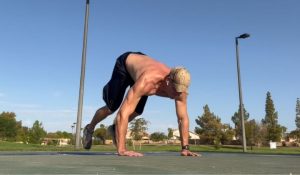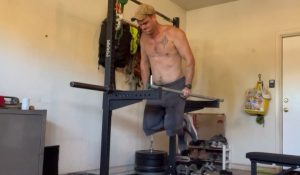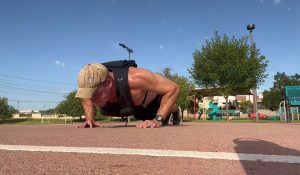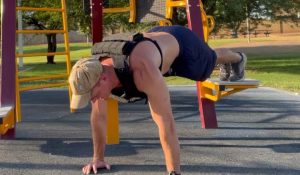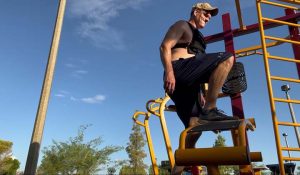In recent articles, I’ve discussed my affinity for various types of supersets. Like tools in the toolbox, they are useful for different tasks. In this article, I’d like to discuss when, how, and why to perform post-exhaustion supersets.
Post-exhaustion supersets are a method of pairing two exercises together that utilize the same muscle groups, where the heavier exercise gets placed first and the easier exercise is placed second. They are a form of agonistic superset, and they are especially good for stimulating new growth during a plateau.
What are post-exhaustion supersets?
A post-exhaustion superset is a type of agonist superset where you perform two exercises back-to-back for the same muscle group with little to no rest in between.
The second exercise is performed at a lighter weight, typically to failure or near failure. The goal is to exhaust the muscle group with the first exercise and then push it even further with the second exercise.
The advantages of using the post-exhaustion technique is that it allows us to pick and target a particular muscle group from a compound exercise. This is in direct contrast to how we use antagonistic supersets, wherein we’re utilizing different muscle groups back-to-back to save time.
Take the case of:
- Bench press followed by lying tricep extensions, skull crushers, or a similar tricep isolation exercise. This superset would cause the triceps to fatigue before the chest, and would be useful for a lifter who wants to specifically develop the triceps.
- Bench press followed by chest flies, cable crossovers, or a similar chest isolation movement. This superset would cause the chest the fatigue before the triceps, and would be useful for the lifter who’s tricep growth tends to outpace his chest.
However, we don’t only need to use post-exhaustion supersets using a multi-joint compound movement followed by a single joint isolation exercise. We could always perform exercises that target exactly the same muscle groups:
- Dips followed by push-ups
- Pull-ups followed by inverted rows
- Bulgarian split squats followed by walking lunges or air squats
How pre and post-exhaustion supersets differ
Though these two techniques cross over in many ways, I find that they serve slightly different purposes (read the full guide on pre-exhaustion supersets here). In practice, pre-exhaustion and post-exhaustion supersets could be utilized in the same program, but I tend to find that:
- Choose pre-exhaustion training when your goal is targeted strength training for a particular muscle group that’s “stuck” or create a weak point in a particular lift (for example, to bring the strength of the quads in order to improve performance on the back squat).
- Choose post-exhaustion supersets when your goal is to totally exhaust a particular muscle group by maximizing muscle recruitemtn to stimulate new growth (hypertrophy) in that muscle group.
Who should use post-exhaustion supersets?
Post-exhaustion supersets are an advanced training technique that should be used by intermediate to advanced lifters. As I’ve stated in other articles on supersets, there’s no need to fix something that ain’t broke.
If you’re still getting progress from a basic routine of squats, push-ups, and pull-ups, or a lifting program like Stronglifts 5×5, then there’s no need to reinvent the wheel by trying to incorporate an advanced lifting technique into your training before you really need to.
Therefore, post-exhaustion supersets are most useful for people who:
- Already have basic proficiency on the exercises they’re planning to use
- Have stalled out in some area of their training and are trying to stimulate new growth
Examples of post-exhaustion supersets in action
Chest
- Barbell bench press + push-ups
- Incline dumbbell press + cable crossovers
- Dumbbell flyes + push-ups
Back
- Pull-ups + lat pulldowns
- Barbell rows + cable rows
- One-arm dumbbell rows + lat pulldowns
Shoulders
- Barbell overhead press + lateral raises
- Dumbbell shoulder press + front raises
- Seated dumbbell press + upright rows
Arms
- Barbell bicep curls + hammer curls
- Tricep pushdowns + skull crushers
- Dumbbell curls + tricep extensions
Legs
- Squats + leg extensions
- Deadlifts + calf raises
- Lunges + leg press
How to program post-exhaustion supersets
As with all things fitness, the ways we can incorporate techniques into our routines are only limited by our creativity.
Programming post-exhaustion supersets can be done in several ways:
- Use a post-exhaustion superset as the last set of a particular exercise, when you’re looking to exhaust the muscle fibers fully and then leave the gym
- Put post-exhaustion supersets on a hypertrophy day for a particular bodypart, and then basic strength work (say, a straight 5×5) on another day during the week after the muscles have had a chance to recover.
- Use post-exhaustion supersets exclusively for a particular muscle group you’re trying to improve, for 8-12 weeks at a time, during a hypertrophy phase.
I would advise that you count each set of a post-exhaustion superset as two sets if you’re using a “weekly volume” approach to lifting. For example, if you’re attempting to hit 12 sets per week for triceps and chest, then a single set of a dip and push-up superset would count as two toward your weekly goal.
Final thoughts
Post-exhaustion supersets can be a great way to challenge yourself and break through plateaus in your lifting or weighted calisthenics routine.
They are an advanced technique that can result in great rewards for intermediate to advanced lifter. By incorporating post-exhaustion supersets into your training program for 8-12 weeks at a time, you can bust through plateaus and finally hit the numbers you’re looking for!






